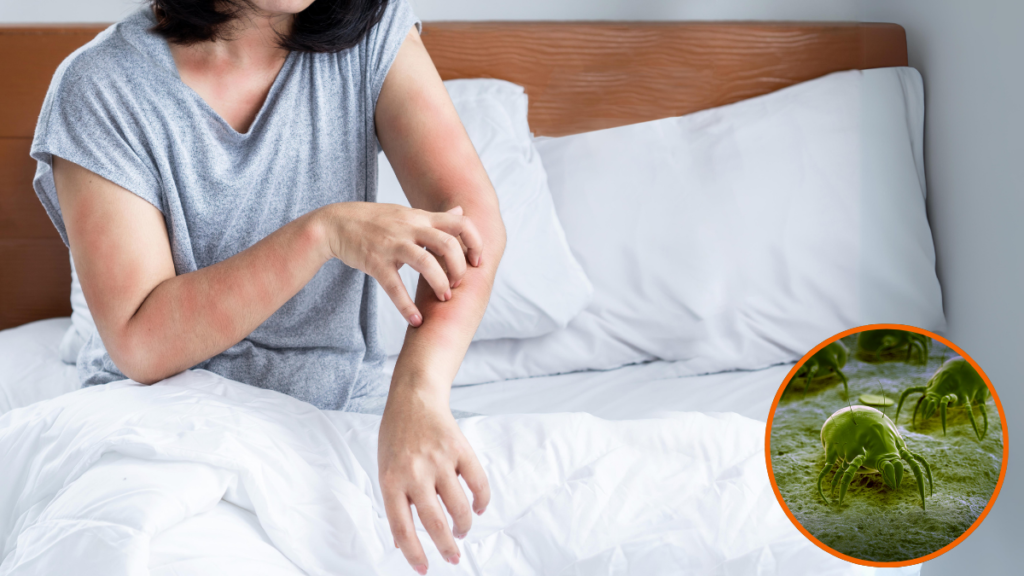
Do you wake up in the morning feeling puffy eyed, runny nose, catarrh, sneezing, coughing or wheezing? Is your eczema or asthma out of control in the winter months once the heating has been switched on? Then you could have House Dust Mite (HDM) allergy.
What’s the allergen?
HDMs are microscopic creatures that live in our homes (e.g. pillows, mattresses, carpets, curtains, rugs, padded furniture, cuddly toys) and feed on tiny flakes of human skin and other debris e.g. bacteria shed from human bodies. The mites themselves are harmless i.e. they can’t bite you but they cause allergic reactions when their droppings (the HDM allergen) are breathed in. Each mite can produce 20 droppings a day which are so small they become airborne. The droppings can continue to cause allergic symptoms even after the HDM has died.
More about mites
There are many species of mites, with Dermatophagoides pteronyssinus (European HDM) and Dermatophagoides farinae (American HDM) being the most important allergy-causing mites. They prefer warm, damp areas that become humid such as your bedroom when the heating is turned on in winter. In fact, the life cycle of a HDM is temperature dependent (optimal temperatures over 23°C) and humidity needs to be above 50% (less humidity causes drying out and mite death). The mite is able to survive for many months in dry, low temperatures in it’s early development in a dormant state, waiting for the right conditions to grow.
Testing for HDM allergy
This can be done through skin prick testing or IgE blood testing. Skin prick testing is where a droplet of HDM allergen is put on the skin which is then pricked with a lancet. A positive result for HDM allergy is when the skin at the prick site becomes raised with a yellowish skin wheal surrounded by red skin. Results are instant, visible to the patient, allowing advice and treatment to be given straight away.
IgE blood testing for HDM is a simple blood test looking at circulating allergy antibody (IgE) levels against several types of HDM. Results take a few days and can be sent via email or given in person at follow-up. Results are graded 0-6; 0 being undetectable low level up to 6 being very high level IgE.
For more information on these tests, please see Dr Harrison’s blog on allergy testing at ROC
Treatment options
The first aim is to decrease the numbers of HDM in your home, as well as decreasing your exposure to the allergen.
- Reduce dampness – open windows or vents in kitchens during and after cooking and bathrooms during and after bathing. Keep bedroom windows/vents open. Avoid drying clothes indoors. Run central heating a few degrees lower especially in the bedroom.
- Washing sheets, pillowcases and duvet covers in high temperatures (ideally over 60°C to kill the HDM) every 2 weeks
- Prevent dust build up – regularly damp-wipe clean surfaces/objects and window. Vacuum soft furnishings and curtains. Vacuum carpets/rugs. Damp mop floors. Vacuum mattresses every 2 weeks.
- Use duvets that are made of synthetic material
- Cover all mattresses, duvets and pillow with micro-porous membrane covers that act as an allergen barrier. These can be easily bought online or from the big high street chains.
- Try to avoid cuddly toys in bedroom/on the bed. Otherwise once a month put the toys in the freezer for 12 hours to kill the HDM.
- Allergic child should not sleep in the bottom bunk bed where allergens can fall onto them.
- Replace carpets if possible with lino or wood flooring. If getting new carpets, choose a very short pile synthetic carpet rather than wool etc.
- Consider using a dehumidifier in the bedroom, and especially if clothes need to be dried inside.
Ideally the above should be carried out over the whole house but if this is not possible, try and focus on the rooms where you spend most of your time i.e. the bedroom or sitting room.
The second options are medications focused on your symptoms such as anti-histamine tablets available over the counter or some prescription-only. Aim to use once daily tablets that are non-drowsy. Nasal sprays are also available for runny nose and sneezing, as well as eye drops for itchy swollen eyes. Also strong steroids creams for difficult-to-manage eczema.
Non-medication options are also available such as:
- Immunotherapy or desensitisation treatment called Acarizax, that causes tolerance to HDM allergen by blocking and then switching off the immune system off to HDM. It is a tablet taken daily that dissolves under the tongue and needs to be continued for many months, often years.
- Rhinolight – this is the latest medication-free treatment for nasal symptoms HDM allergy and ROC is proud to be the only UK clinic offering this to our patients. It is a light treatment up both nostrils for only 3 minutes, 8 times over 6 weeks, at your convenience. It works in a similar way to an anti-histamine by stopping the allergic response in the nasal lining. You can read more about this novel treatment here.
If you have any general allergy questions or would like testing and treatment for House Dust Mite allergy, book an appointment with one of our private doctors today!


One Response
I appreciate everything that you mentioned Thanks for sharing